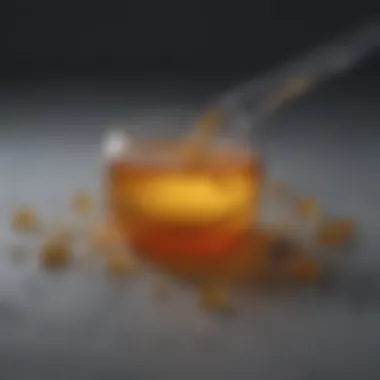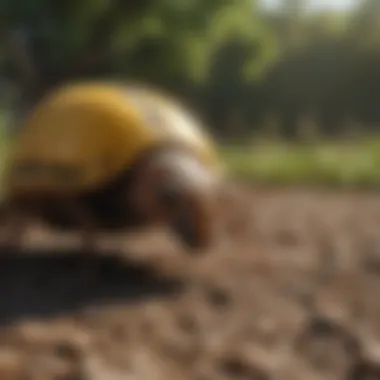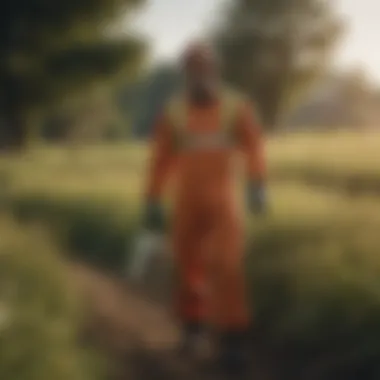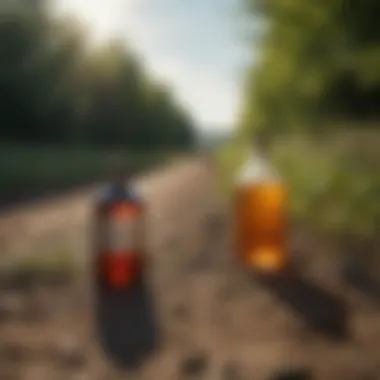Permethrin Liquid Concentrate in Agriculture: A Guide


Intro
Permethrin liquid concentrate is an important tool in modern agriculture. This pesticide plays a crucial role in managing pests that threaten crops and overall production. By understanding its chemical properties and how it functions, farmers can make informed decisions that enhance their farming practices. With the increasing demand for sustainable methods in agriculture, the exploration of permethrin's applications becomes vital.
Topic Overview
Definition and Importance
Permethrin is a synthetic pyrethroid, mimicking natural insecticides derived from chrysanthemums. The importance of permethrin lies in its effectiveness at controlling a wide variety of pests. It is particularly noted for its residual action, meaning it continues to work long after application. This quality is valuable in farming, where ongoing pest control is often necessary.
Brief History and Evolution
Permethrin was first developed in the 1970s. Since then, it has undergone several assessments to ensure its safety and effectiveness. The evolution of this chemical reflects the changing approaches in pest management, especially for farmers looking to minimize chemical usage while maximizing results. These considerations have influenced its adoption in various agricultural sectors.
Key Techniques and Innovations
Sustainable Farming Practices
Incorporating permethrin into sustainable practices requires careful planning. Farmers must balance pest control needs with environmental health. Implementing integrated pest management (IPM) strategies that utilize permethrin can contribute to sustainability. This includes using the pesticide in conjunction with natural predators and crop rotation to minimize reliance on chemical solutions.
Advanced Agronomic Technologies
The modernization of agriculture through technology enhances the use of permethrin. For instance, precision application methods ensure that the chemical is only applied where needed. These technologies reduce waste and protect non-target organisms, further promoting sustainable practices in farming. Farmers can adopt tools such as drones for precise spraying to optimize pest control efficacy.
Practical Applications
Step-by-Step Guides
To effectively use permethrin, farmers should follow specific applications. Here is a general guide:
- Preparation: Read the label to understand dilution rates and Safety Data Sheets (SDS).
- Application: Use protective gear and apply evenly across the targeted area. Avoid windy days to minimize drift.
- Monitoring: After application, monitor the field for pest activity and any non-target species affected.
- Documentation: Keep records of applications to assess effectiveness and adhere to regulations.
Case Studies or Real-World Examples
Farmers have successfully implemented permethrin in regions facing pest outbreaks. For instance, a case study in California showcased how permethrin effectively reduced aphid populations on cotton crops, leading to a marked improvement in yield. This real-world application highlights permethrin’s practicality in addressing immediate agricultural challenges.
"Understanding the role of chemicals like permethrin, while adhering to safety and environmental guidelines, is key to modern agriculture."
Prologue to Permethrin Liquid Concentrate
Permethrin liquid concentrate is a significant agent in agricultural pest management. Understanding its role is essential for farmers and agriculture enthusiasts. This section will provide insights into its definition, composition, and historical background, shedding light on why permethrin is widely used in various agricultural practices.
Definition and Composition
Permethrin is a synthetic insecticide belonging to the pyrethroid family. It mimics the natural insecticides produced by chrysanthemum flowers. The chemical composition of permethrin involves a series of complex organic compounds that perturb the normal functioning of pests. The formulation typically consists of a high concentration of permethrin itself mixed with inert ingredients that facilitate application and stability. This concentration can vary—often, products contain 10% to 36% permethrin. Knowing the exact formulation is crucial for effective use.
Historical Background and Usage
The history of permethrin dates back to the 1970s. It has been utilized primarily as an insecticide for agricultural purposes. Initially developed for use in public health to control mosquito populations, its effectiveness drew interest from agricultural sectors. Over the decades, it has been integrated into pest control strategies for crops such as cotton, fruits, and vegetables. Moreover, permethrin is also used in livestock management, helping to control ectoparasites.
As farmers face increasing challenges with pest resistance, the relevance of permethrin continues to grow. Farmers need to consider its benefits, such as its residual activity and low toxicity to humans and animals. However, environmental implications must also be taken into account, as misuse can lead to negative impacts on non-target species and ecological balances. It is essential to know both the advantages and limitations when implementing permethrin in agricultural practices.
Mechanism of Action
Understanding the mechanism of action of permethrin liquid concentrate is critical for agricultural practitioners. This knowledge enables effective pest management strategies and informs safe application practices. The interaction between permethrin and target pests dictates the formulation and method of use, making this topic essential for optimizing results while minimizing risks to non-target species.
Chemical Interactions with Pests
Permethrin is a synthetic pyrethroid that works primarily by disrupting the normal functioning of the nervous system in insects. When pests come into contact with this compound, it binds to specific sites in the neuronal membranes. The result is a prolonged opening of sodium channels, leading to continuous nerve signal transmission. This hyperactivity ultimately culminates in paralysis and death of the targeted insects.


The effectiveness of permethrin is particularly noteworthy for its rapid action against a wide range of pests. For example, common agricultural nuisances like aphids, thrips, and spider mites exhibit extreme susceptibility when exposed to this compound. The efficacy can vary slightly based on the pest species, but overall, permethrin remains a robust option in agricultural pest control.
"Permethrin effectively combines quick action with residual activity, making it a favored choice among farmers."
Impact on Non-Target Species
While permethrin is effective against pests, it is essential to consider its impact on non-target species. The chemical's action does not exclusively affect intended pests; it can also present risks to beneficial organisms. For instance, pollinators like bees and certain predatory insects may be vulnerable when permethrin applications are not carefully managed.
To mitigate such risks, farmers should incorporate strategies that minimize exposure to non-target species. Adjustable application methods, timing, and weather considerations are vital factors in guarding against unintended collateral damage. For example, applying permethrin during periods of low insect activity and ensuring that beneficial plants are not in bloom may enhance ecological safety.
In summary, understanding the mechanism of action of permethrin is fundamental for effective pest management in agriculture. Although it provides formidable pest control, careful considerations are necessary to protect non-target species, ensuring both productivity and ecological integrity.
Permethrin Applications in Agriculture
Permethrin liquid concentrate plays a significant role in modern agricultural practices. It serves vital purposes that extend beyond simple pest control. Understanding its applications can help practitioners implement effective strategies while also weighing potential risks and benefits.
Pest Control in Crop Production
Permethrin is largely recognized for its effectiveness in pest management. When applied to crops, it targets a broad spectrum of pests, including aphids, beetles, and caterpillars. By using permethrin, farmers can achieve substantial reductions in pest populations, which often translates to improved crop yields. This reduction is critical as pests can decimate entire crops if not managed properly.
The application of permethrin is particularly important in maintaining the overall health of crops. Healthy plants have better resistance to diseases, which means reduced reliance on additional chemical pest control measures. This aligns with the principles of sustainable agriculture, where the emphasis is on environmentally responsible methods. When utilizing permethrin, farmers must follow recommendations concerning dosage and timing to optimize effectiveness. Overuse can lead to pest resistance, diminishing the long-term benefits of its application.
Additionally, permethrin can be combined with other pest control methods as part of an integrated pest management strategy. This approach not only enhances pest control efficacy but also minimizes potential adverse effects on non-target organisms. Such strategies have proven to be more sustainable over time, thereby supporting the long-term viability of agricultural practices.
Utilization in Livestock Management
Beyond crop production, permethrin is also beneficial in livestock management. For instance, it is often used to control external parasites like ticks, fleas, and lice on animals. These parasites can severely affect livestock health, leading to decreased productivity and, in some cases, even disease transmission.
By treating livestock with permethrin, farmers can maintain higher health standards. This is crucial in sectors such as dairy and meat production, where animal welfare directly correlates with quality and yield. Improved health translates into better growth rates and higher quality products.
Another significant advantage of permethrin in livestock management is its versatility. It can be administered in various forms, including sprays and pour-ons, allowing flexibility depending on specific circumstances. However, it is essential to adhere strictly to safety protocols to ensure that treated animals are not adversely affected and that the chemical's residues are within acceptable limits upon product harvesting.
Formulation and Product Variability
Understanding formulation and product variability is key in the effective application of permethrin liquid concentrate. The effectiveness of permethrin is not static; rather, it varies based on formulation types, concentrations, and intended use. Recognizing these differences allows agricultural practitioners to select the appropriate products for their specific needs, improving pest management outcomes.
Types of Permethrin Products
Permethrin is available in various formulations. Common types include:
- Emulsifiable Concentrates (EC): These are mixed with water and offer strong efficacy against pests. Their oily nature allows for an even coat on plant surfaces.
- Wettable Powders (WP): These require dispersal in water. They provide flexibility in mixing and are useful for large-area applications.
- Ready-to-Use Aerosols: These products do not require dilution, providing convenience for smaller areas or targeted pest control.
- Granular Formulations: Such products are applied to the soil or plant base, targeting pests in the soil.
Selecting the right type depends on factors like the area of application, target pests, and environmental conditions. Different products have unique attributes affecting their performance and efficiency in pest management.
Concentration Differences and Their Implications
Concentration variations in permethrin products also play a significant role in agriculture. The concentration is often indicated on the product label, commonly expressed as a percentage. Here are some implications:
- Effectiveness: Higher concentrations may provide quicker pest knockdown but can also increase the risk of non-target effects. Proper calibration is essential.
- Resistane Management: Using a lower concentration combined with other pest control methods can help mitigate resistance, improving long-term pest management in cropping systems.
- Regulatory Compliance: Some agricultural regulations dictate the maximum allowable concentrations for different uses. Compliance is critical to avoid legal issues and ensure safe practices.
From a farm management perspective, understanding product concentration helps tailor pest control strategies that align with both efficacy and safety.
Each form and concentration of permethrin has its advantages and best-use scenarios. Awareness of these factors ensures that farmers can apply the right solution effectively, promoting sustainable practices in pest management.
Field Application Techniques
Field application techniques are critical in the effective utilization of permethrin liquid concentrate in agriculture. Proper techniques enhance efficacy and minimize waste and environmental impact. The choice of method impacts not just pest control outcomes but also the safety of the applicator and surrounding ecosystems. A clear understanding of these techniques leads to better results in pest management practices.
Preparation of Permethrin Solutions
Preparation of permethrin solutions is an essential step for achieving optimal efficacy. The concentration of the solution is determined by the target pest and crops being treated. Each product comes with specific instructions that guide practitioners in achieving the correct dilution ratios.


It’s crucial to utilize clean equipment when preparing solutions to avoid contamination. Mixing in a shaded area helps maintain stability and effectiveness of the solution. Ensuring thorough agitation during mixing helps distribute permethrin evenly, providing consistent application.
Application Methods
Spraying
Spraying is one of the most versatile methods for applying permethrin. This method allows for targeted treatments, enabling farmers to focus on specific areas that require protection. The flexibility of choosing different nozzle sizes makes it possible to adjust the spray pattern depending on the crop and pest situation. This adaptability contributes to its popularity in pest management.
However, sprayers should be set up to minimize drift, as this can affect non-target species and lead to unwanted environmental effects. Proper calibration of the equipment ensures that the correct dosage is applied, enhancing the effectiveness of the treatment.
Drip Irrigation
Drip irrigation is a more precise application method that can also deliver permethrin effectively. This method allows for direct application to the root zone, which can reduce the runoff and evaporation of the product. Its key characteristic is efficiency, offering minimal water usage while targeting specific plants more accurately.
The benefit of drip irrigation is the lower exposure risk to non-target organisms. However, it requires initial setup costs, as well as regular maintenance to avoid clogs and ensure even distribution of the solution, which can be time-consuming.
Granular Functionality
Granular functionality is an alternative application method that involves applying permethrin in granular form. This method allows for application before the pests become a problem, acting as a preventive measure. Granular permethrin works by poisoning pests upon contact or ingestion, leading to effective pest management especially in soil-dwelling insects.
One advantage of granular application is the ease of use, as it does not require special equipment like sprayers or irrigation systems. However, it may require higher volumes to cover large areas effectively and depends on environmental conditions such as moisture and humidity for optimum effectiveness.
In summary, each application method for permethrin has specific roles, benefits, and considerations. Selecting the appropriate technique is vital for effective pest control while ensuring safety and sustainability in agricultural practice.
Safety and Handling Protocols
Ensuring the safety and proper handling of permethrin liquid concentrate in agricultural practices is crucial. This involves understanding potential hazards, implementing protective measures, and knowing the appropriate responses to emergencies. Failing to adhere to safety protocols can result in health risks not only to agricultural workers but also to the environment.
Personal Protective Equipment
Wearing the appropriate Personal Protective Equipment (PPE) is critical when handling permethrin. This equipment can help mitigate exposure risks during application and mixing. Recommended PPE includes:
- Chemical-resistant gloves: These are essential for protecting the hands from skin absorption of permethrin.
- Eye protection: Safety goggles should be used to prevent splashes from contacting the eyes.
- Respirators: Depending on the concentration and method of application, a respirator may be necessary to protect against inhalation of vapors.
- Protective clothing: Long-sleeved shirts and trousers made from chemical-resistant material can further reduce skin exposure.
By properly utilizing PPE, agricultural practitioners can substantially reduce the risk of adverse health impacts and maintain a safer working environment.
Emergency Procedures and First Aid
In the event of exposure or an incident involving permethrin, immediate action is vital. Familiarizing oneself with emergency procedures and first aid protocols is essential. Common strategies include:
- Inhalation exposure: If an individual inhales vapors, they should be moved to fresh air immediately and monitored for any breathing difficulties.
- Skin contact: Affected skin should be washed thoroughly with soap and water for at least 15 minutes. If irritation persists, seeking medical attention is recommended.
- Eye contact: If permethrin comes into contact with the eyes, it must be rinsed gently with water for several minutes. It is essential to remove contact lenses if they are in place and continue rinsing until medical help can be obtained.
- Ingestion: Do not induce vomiting. Instead, contact poison control or medical professionals immediately for guidance.
"Knowing how to respond effectively to exposure can save lives and minimize harm."
Training personnel on these emergency procedures can not only enhance workplace safety but also prepare them for unexpected situations that may arise during handling and application of permethrin. Always ensure that first aid kits are readily available and that workers know their location.
Environmental Considerations
The discussion of permethrin liquid concentrate in agriculture cannot be complete without addressing environmental considerations. Applying such chemicals raises crucial questions about their effects on ecosystems and sustainability. Understanding how permethrin interacts with its surroundings is imperative for responsible agricultural practices.
Potential Ecotoxicity
Permethrin, while effective against various pests, poses some risk to the environment. Its potential ecotoxicity emerges from its chemical properties, particularly its persistence in various ecological contexts. Studies have shown that permethrin may adversely affect beneficial insects, such as bees and other pollinators.
- Effects on Aquatic Life: This compound can be toxic to fish and other aquatic organisms. It is essential to avoid runoff during application, as water bodies can become contaminated.
- Impact on Biodiversity: Long-term use of permethrin can disrupt the balance of natural ecosystems.
- Human Health Concerns: Although the primary focus is on agricultural effects, there are implications for human health as well. Exposure to permethrin can result in health issues, making its careful management essential.
Impact on Soil and Water Quality
The application of permethrin does not only affect pests; it also has potential ramifications on soil and water quality. Permethrin can leach into the soil and affect the microbial community. Beneficial soil bacteria and fungi can be impacted, which in turn affects soil health and fertility.


- Soil Structure: Healthy soil is crucial for plant growth, and contaminants can disrupt this. If permethrin alters the structure or composition of soil, it can lead to long-term agricultural challenges.
- Water Quality: Contamination of surface and groundwater is a key concern with permethrin use. If not managed properly, this chemical can enter aquatic systems, affecting not just wildlife but also human water supplies.
In essence, while permethrin offers significant advantages in pest management, its environmental impacts must be critically evaluated to safeguard ecosystems.
To conclude, farmers and agricultural professionals must implement best practices to minimize the ecological footprint of permethrin. Awareness and action are critical to ensuring that effective pest control does not come at the cost of environmental health.
Regulatory Landscape
Understanding the regulatory landscape surrounding permethrin liquid concentrate is vital for its safe and effective application in agriculture. Regulatory guidelines ensure that the use of permethrin is compliant with safety and environmental standards, which ultimately protect human health and ecosystems. In many countries, these regulations shape the development, registration, and monitoring of agricultural chemicals, ensuring they are used responsibly.
Approval and Registration Processes
The approval and registration process for permethrin involves several steps aimed at reviewing its safety, efficacy, and environmental impact. This process starts with manufacturers submitting data to regulatory bodies such as the Environmental Protection Agency (EPA) in the United States or similar agencies worldwide. The data includes evidence from laboratory tests, field studies, and risk assessments.
The regulatory authorities assess various factors:
- Toxicity: Potential harm to humans, animals, and the environment.
- Environmental Fate: How permethrin behaves in soil, water, and air.
- Efficacy: The effectiveness of the product in controlling pests.
Once the review process is completed, if the evidence meets the required standards, the product is granted registration. This registration must be maintained through ongoing compliance with regulations and can require periodic re-evaluation based on new research or findings related to the chemical's effects.
Compliance with Agricultural Standards
Compliance with agricultural standards is crucial for ensuring that permethrin is used responsibly and effectively. These standards vary by country and often align with guidelines provided by organizations such as the Food and Agriculture Organization (FAO) and the World Health Organization (WHO).
Farmers and agricultural practitioners must adhere to several principles, such as:
- Adhering to Label Instructions: Using permethrin in accordance with label directions ensures proper dosage and application methods hav been followed.
- Monitoring and Reporting: Keeping track of applications and any adverse effects contributes to collective data that can influence future guidelines.
- Integrated Pest Management (IPM): Incorporating permethrin within IPM strategies to reduce reliance on chemical controls and enhance sustainability.
Effective compliance with these standards helps to mitigate risks associated with chemical use, ensuring that permethrin contributes positively to agricultural practices.
Alternatives to Permethrin
The significance of exploring alternatives to permethrin lies in the quest for sustainable agriculture and responsible pest management practices. While permethrin offers effective pest control solutions, its usage may come with consequences that warrant consideration of other methods. These alternatives can provide valuable benefits such as reduced environmental impact, safety for non-target species, and adherence to organic farming practices. Understanding these alternatives aids farmers in making informed decisions that balance efficacy and ecological responsibility.
Organic Pest Control Options
Organic pest control options have gained traction in recent years due to increasing consumer demand for chemical-free produce. Among these methods are natural products derived from plants and minerals. For instance, neem oil, extracted from the seeds of the neem tree, is known for repelling a wide range of pests. Similarly, insecticidal soaps can effectively target soft-bodied insects like aphids while being safe for beneficial insects such as ladybugs.
Moreover, biological control tactics harness natural predators to keep pest populations under control. For example, introducing ladybugs or parasitic wasps can significantly reduce aphid infestations without harmful side effects on the ecosystem. This strategy not only aids pest management but also promotes biodiversity.
Integrated Pest Management (IPM) Strategies
Integrated Pest Management (IPM) is a comprehensive approach that combines various pest control methods, aiming to minimize chemical use and enhance sustainability. IPM strategies focus on monitoring pest populations and employing multiple tactics for management, which can include cultural, biological, and mechanical controls.
Key components of IPM include:
- Monitoring: Regular observations of pest populations and damage levels to inform management decisions.
- Cultural Controls: Altering farming practices such as crop rotation or selecting pest-resistant plant varieties to reduce pest establishment.
- Biological Controls: Utilizing beneficial organisms to suppress pest populations.
- Mechanical Controls: Employing traps, barriers, or other physical methods to prevent pest access.
- Chemical Controls: Using targeted, low-impact pesticides only when necessary, prioritizing alternatives like organic products when possible.
Implementing IPM not only addresses pest problems effectively but also mitigates risks associated with chemical pesticides, fostering a healthier environment for both crops and surrounding ecosystems.
Culmination
The conclusion of this article holds significant importance as it encapsulates the key findings discussed throughout the text regarding permethrin liquid concentrate. It synthesizes the various aspects of the chemical, from its applications to the safety measures necessary for effective usage. Understanding these key points is essential for practitioners in agriculture who rely on such products to manage pests while ensuring environmental conservation.
Synthesis of Key Points
To summarize, several essential points about permethrin liquid concentrate emerge from this guide:
- Chemical Composition: Permethrin is a synthetic pyrethroid, known for its efficacy in pest management.
- Mechanism of Action: It acts primarily through neurotoxic effects on targeted pests, disrupting their neural transmission and leading to mortality.
- Applications in Agriculture: This chemical finds extensive use in both crop management and livestock protection, highlighting its versatility.
- Safety Protocols: Implementing proper handling and personal protective equipment is crucial to minimize risk to users and mitigate environmental impact.
- Regulatory Compliance: Awareness of local regulations regarding usage and registration fosters responsible application aligned with agricultural standards.
Future Directions in Research and Application
Looking ahead, research on permethrin can focus on various avenues to enhance its utility and safety in agricultural practices:
- Resistance Management: Future studies could analyze pest resistance patterns to permethrin and propose solutions to maintain efficacy.
- Integration with Organic Methods: Exploring the compatibility of permethrin with organic pest control strategies can open doors for sustainable farming practices.
- Environmental Impact Assessments: Conducting detailed studies on its long-term effects on soil and water ecosystems is vital to understand and enhance sustainability in agriculture.
A circular approach that emphasizes both the application of permethrin and the need for safety and environmental awareness will be paramount in shaping future agricultural practices. This dual focus ensures the effective management of pests while safeguarding the ecosystems in which we operate.



